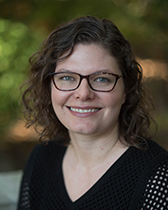Magdalena Osburn
Associate Professor, Seminar Director, Nemmers Host
M.S. Geobiology, California Institute of Technology, Division of Geological and Planetary Science
B.A. summa cum laude, Earth & Planetary Sciences, Environmental Studies, Washington University in St. Louis
Curriculum Vitae

- maggie@earth.northwestern.edu
- Website
- 847-491-4254
- Tech F291/F292
Research
Biological molecules record information about both their formation environment and the organisms that produce them. I use a class of molecules called lipids to study the habits of modern and ancient microbes. Lipids are found in the membranes of all organisms and their structures can be highly diagnostic of particular biological groups. Lipids are made primarily of C and H (also N, P, O, and S). As these atoms are incorporated into the lipid structure they preserve isotopic signals of both biological and environmental processes. The major advantage of lipids for geoscientists is that they can be preserved on very long timescales, and thus can archive information about past environments in sediments and rocks. My research applies tools from organic geochemistry, microbiology, and stratigraphy to investigate microbial and biogeochemical cycling in both modern and ancient environments.
A major ongoing portion of my research focuses on understanding what type of information is record by the hydrogen isotopic composition of lipids. We know that D/H reflects environmental water, but it can also vary with humidity, salinity, and, most importantly for my research, microbial metabolism. This work includes both in lab culturing experiments to expand the data base of isolate D/H, and field studies aimed at understanding the nuances of this technique in particular environments.
Other current and past research topics include:
- Geochemical modeling of aqueous environments to understand the energetic potential and limits of microbial life (Currently focused on the deep subsurface environment)
- Neoproterozoic chemical evolution of the ocean-atmosphere system during extreme isotope excursions (mostly in Oman thus far, Chemostratigraphy, modeling, field work)
- Carbonate sedimentology, stratigraphy, and geochemistry with an emphasis on microbialite preservation and morphology.
Teaching
EARTH 331 - Field Problems in Sedimentary Geology
EARTH 370 - Geobiology
Selected Publications
Casar, C.P.*, Kruger, B.R., Flynn, T.M., Masterson, A.L., Momper, L.M.*, Osburn, M.R.,(2020) Mineral-hosted biofilm communities in the continental deep subsurface, Deep Mine Microbial Observatory, SD, USA. Accepted at Geobiology Feb. 2020
McFarlin, J.M.*, Axford, Y., Masterson, A., Osburn, M.R., (2019) Calibration of modern sedimentary d2H plant wax-water relationships in Greenland lakes Quaternary Science Reviews 225, 1-14. https://doi.org/10.1016/j.quascirev.2019.105978
Osburn, M.R., Kruger, M., Masterson, A., Casar, C.*, Amend, J., (2019) Establishment of the Deep Mine Microbial Observatory (DeMMO), South Dakota, USA. a geochemically stable portal into the deep subsurface. Frontiers in Earth Science 7, 1-17. doi:
10.3389/feart.2019.00196.
Lollar, G., Warr, O., Telling, J., Osburn, M., Sherwood Lollar, B., (2019) 'Follow the Water': Hydrogeochemical Constraints on Microbial Investigations 2.4 km below surface at the Kidd Creek Deep Fluid and Deep Life Observatory. Geomicrobiology Journal
https://doi.org/10.1080/01490451.2019.1641770
Andrews, M.G.*, Jacobson, A.D., Osburn, M.R., Flynn, T.M., (2018) Dissolved carbon dynamics in meltwaters from the Russell Glacier, Greenland Ice Sheet. Journal of Geophysical Research: Biogeosciences, 123. https://doi.org/10.1029/2018JG004458
Johnson, D.B.*, Beddows, P., Flynn, T., Osburn, M.R. (2017) Microbial diversity and biomarker analysis of modern freshwater microbialites from Laguana Bacalar, Mexico, Geobiology 16, 319-337
Osburn, M. R., Dawson, K. S., Fogel, M. L., & Sessions, A. L., (2016) Fractionation of Hydrogen Isotopes by Sulfate- and Nitrate-Reducing Bacteria. Frontiers in Microbiology 7, 318–316.
